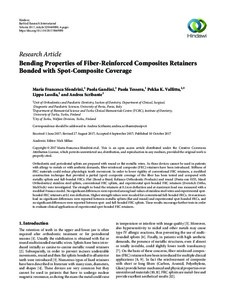Bending properties of fiber-reinforced composites retainers bonded with spot-composite coverage
Sfondrini Maria Francesca; Gandini Paola; Tessera Paola; Vallittu Pekka K; Lassila Lippo; Scribante Andrea
Bending properties of fiber-reinforced composites retainers bonded with spot-composite coverage
Sfondrini Maria Francesca
Gandini Paola
Tessera Paola
Vallittu Pekka K
Lassila Lippo
Scribante Andrea
HINDAWI LTD
Julkaisun pysyvä osoite on:
https://urn.fi/URN:NBN:fi-fe2021042717371
https://urn.fi/URN:NBN:fi-fe2021042717371
Tiivistelmä
Orthodontic and periodontal splints are prepared with round or flat metallic wires. As these devices cannot be used in patients with allergy to metals or with aesthetic demands, fiber-reinforced composite (FRC) retainers have been introduced. Stiffness of FRC materials could reduce physiologic tooth movement. In order to lower rigidity of conventional FRC retainers, a modified construction technique that provided a partial (spot) composite coverage of the fiber has been tested and compared with metallic splints and full-bonded FRCs. Flat (Bond-a-Braid, Reliance Orthodontic Products) and round (Penta-one 0155, Masel Orthodontics) stainless steel splints, conventional FRC splints, and experimental spot-bonded FRC retainers (Everstick Ortho, StickTech) were investigated. The strength to bend the retainers at 0.1mm deflection and at maximum load was measured with a modified Frasaco model. No significant differences were reported among load values of stainless steel wires and experimental spot-bonded FRC retainers at 0.1mm deflection. Higher strength values were recoded for conventional full-bonded FRCs. At maximum load no significant differences were reported between metallic splints (flat and round) and experimental spot-bonded FRCs, and no significant differences were reported between spot-and full-bonded FRC splints. These results encourage further tests in order to evaluate clinical applications of experimental spot-bonded FRC retainers.
Kokoelmat
- Rinnakkaistallenteet [27094]
